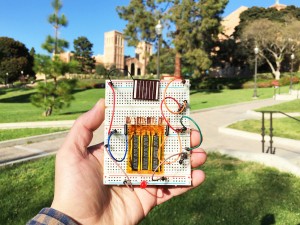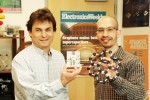Researchers with the California NanoSystems Institute recently developed a new battery-like supercapacitor, a device that stores charge, which may rival conventional energy storage technology.
The Kaner Laboratory, where the capacitor was created, published a paper on the technology in early March and presented it Saturday at the Southern California Undergraduate Research Conference in Chemistry and Biochemistry in San Diego. According to researchers, the technology may help address energy storage problems bottlenecking next-generation electronics, including electric cars and wearable devices, such as Google Glass. Several UCLA students are also involved in the laboratory’s work.
Postdoctoral research associate Maher El-Kady said the capacitor uses graphene materials, which are made from single layers of carbon, and inexpensive electrolytes normally used in batteries to make a hybrid capacitor and battery. This design combines elements of both devices by allowing both faster recharge time and larger storage capacity.
“Our lab works with new materials, especially carbon, to solve modern issues involving solid-state electronics,” said Richard Kaner, the head of Kaner Laboratory. “In fact, we began working with graphene before its official discovery.”
He explained that there is a major difference between capacitors and conventional batteries. The former stores a small amount of energy but charges quickly. In contrast, the batteries have a high capacity but charge slowly.

“For the graphene project, the lab is about targeting technology that is integral to our everyday lives,” said Lindsay Chaney, a fourth-year chemistry/materials science student who worked on the project. “Energy storage is part of all of our portable devices. We want to make a difference by changing how we store energy.”
Chaney said the lab’s new technology has many potential applications.
One such application is the storage of renewable energy, El-Kady said. A major obstacle facing solar power, he said, is the storage of solar energy when the sun isn’t shining. Panels need to be able to provide a constant stream of energy, both day and night. The supercapacitors’ large storage and less expensive design could improve this issue, he added.
Another application is in the field of electric vehicles. He said graphene supercapacitors might offer the storage and recharge time necessary to drive down the price point of electric vehicles, possibly making them more common on the road.
El-Kady said the lab bridged the gap between the two technologies by using graphene as the primary energy storage material.
Chaney said he thinks the supercapacitors’ primary benefit over conventional batteries is their ability to recharge in a matter of seconds. Batteries used in cell phones, by comparison, take upward of three hours to charge.
In addition, despite their lower cost, the capacitors are long-lasting compared to more typically used battery materials, El-Kady said.
The Kaner Laboratory is still developing the capacitors, and they are not currently in industrial production. El-Kady said mass production is the long-term goal for a more compact and higher-capacity design.
